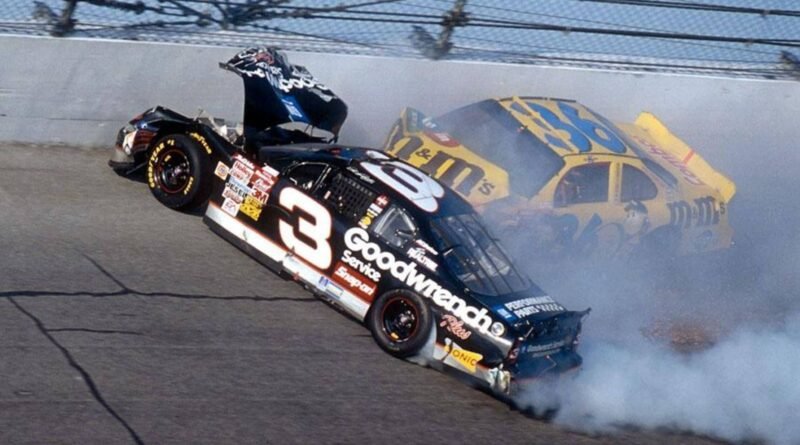Dale Earnhardt Crash: The NASCAR Tragedy That Changed Racing Forever
February 18, 2001 — a date etched into the heart of every NASCAR fan. That Sunday at Daytona wasn’t supposed to end the way it did. It was meant to be a thrilling finale, not a farewell. But in the blink of an eye, the racing world lost one of its greatest legends in what’s now known as the Dale Earnhardt crash.
You don’t have to be a die-hard motorsports fan to feel the weight of that moment. If you’ve ever cheered for an underdog, felt your heart race watching a close finish, or simply admired someone who pushed the limits — then you get it. Dale Earnhardt wasn’t just a driver. He was NASCAR. And that crash? It didn’t just stop a car. It stopped time.
So, what exactly happened that day? Why did it unfold the way it did? And how did it reshape NASCAR as we know it? Buckle up, because we’re diving deep into the high-speed, heartbreaking, and history-making moment of the Dale Earnhardt crash.
What Really Happened During the Dale Earnhardt Crash?
The setting was the 2001 Daytona 500 — the “Super Bowl of Stock Car Racing.” With just one lap to go, Dale Earnhardt Sr. was in third place, playing protector for his team — shielding his son Dale Earnhardt Jr. and teammate Michael Waltrip, who were battling for the win.
As the trio zoomed into turn 4, chaos broke loose. Sterling Marlin’s car made slight contact with Earnhardt’s No. 3 Chevrolet. In a flash, Dale’s car veered down, then up the track, colliding with Ken Schrader’s car and slamming head-on into the concrete wall at 160 mph.
It looked like a typical crash at first — not the most violent by NASCAR standards. But something was horribly wrong. There was no movement from inside the car. No signal. No wave.
iowa ron hutcherson ford torino: The Untold Tale of Racing Legacy and Muscle Car Power
What followed was pure heartbreak.
Key Moments from the Dale Earnhardt Crash Timeline
| Time | Event |
|---|---|
| Lap 199 (Final Lap) | Earnhardt Sr. running 3rd behind Waltrip and Earnhardt Jr. |
| Turn 4 | Contact with Sterling Marlin initiates the crash |
| Collision | No. 3 car crashes head-on into wall at 160 mph |
| Post-crash | No movement from Earnhardt; emergency crews respond |
| 5:16 PM EST | Earnhardt pronounced dead at Halifax Medical Center |
Why Was the Crash Fatal? The Silent Danger of Basilar Skull Fracture
Here’s where it gets haunting. The Dale Earnhardt crash didn’t appear as brutal as many others. But the impact was so direct and so fast that it caused a basilar skull fracture — a fatal injury where the base of the skull separates from the spine. In simpler terms: it’s like cutting the power cord on a computer while it’s still running.
In fact, this exact type of injury had claimed other NASCAR drivers before Dale. But no major action had been taken to address it on a large scale. That is — until Dale’s death forced the world to stop and rethink.
NASCAR Driver Deaths from Similar Injuries (1999–2001)
| Driver | Year | Cause of Death | Track |
|---|---|---|---|
| Adam Petty | 2000 | Basilar skull fracture | New Hampshire Motor Speedway |
| Kenny Irwin Jr. | 2000 | Basilar skull fracture | New Hampshire Motor Speedway |
| Tony Roper | 2000 | Basilar skull fracture | Texas Motor Speedway |
| Dale Earnhardt Sr. | 2001 | Basilar skull fracture | Daytona International Speedway |
These tragic deaths were the wake-up call NASCAR desperately needed.
The Legacy of the Dale Earnhardt Crash — Safety Revolutionized
If there’s a silver lining to such an enormous tragedy, it’s this: the Dale Earnhardt crash saved lives. Literally.
After his death, NASCAR went full throttle into a safety overhaul. And we’re not talking about a few tweaks here and there — we’re talking a full-on transformation of racing safety standards.
A Medieval Knight in a Martial Arts Novel: When Chivalry Meets Chi
Here’s what changed after Dale’s crash:
- MANDATORY HANS Devices: Head and neck restraint systems became mandatory, drastically reducing fatal injuries.
- Safer Barriers Installed: Walls were redesigned with energy-absorbing materials to reduce crash force.
- Car of Tomorrow (CoT): Introduced to improve crash survival through safer cockpit design.
- Advanced Seatbelt Technology: Belts were re-engineered to prevent slippage and improper positioning.
- Full-Time Medical Officials: NASCAR brought onboard trauma experts and standardized emergency protocols.
It’s no exaggeration to say that Dale Earnhardt’s crash ushered in a new era of safety — one where no risk is too small to fix.
FAQs About the Dale Earnhardt Crash
1. What caused the Dale Earnhardt crash?
A slight contact with another car caused Earnhardt’s vehicle to veer into the wall, resulting in a fatal head-on collision.
2. Was Dale Earnhardt wearing safety gear?
Yes, he was wearing a seatbelt, but he wasn’t using the HANS device, which wasn’t mandatory at the time.
3. What was Dale Earnhardt’s cause of death?
He died instantly from a basilar skull fracture — a fatal injury caused by rapid deceleration upon impact.
4. Did NASCAR make changes after the crash?
Absolutely. NASCAR implemented multiple safety reforms including mandatory HANS devices, SAFER barriers, and car redesigns.
5. Why is the Dale Earnhardt crash so significant?
It marked a pivotal moment in motorsports safety, leading to sweeping changes that have since saved countless lives.
Conclusion: A Loss That Changed Everything
The Dale Earnhardt crash wasn’t just another racing accident. It was a gut punch to the entire NASCAR community. We lost more than a driver that day — we lost a legend, a symbol, a father, and a fierce competitor.
But in the shadow of that loss, the sport was reborn. Stronger. Smarter. Safer.
Dale always raced on the edge. Ironically, it was his final race that pushed the edge back — making room for the safety of future generations. His legacy isn’t just in the wins and the championships; it’s in every driver who walks away from a crash today.
Custom Message:
And there you have it — the full story behind the Dale Earnhardt crash, a moment that shook NASCAR to its core and rebuilt it from the inside out. Whether you’re a lifelong fan or just learning about this chapter in racing history, one thing is clear: Dale’s legacy still drives the sport forward.



